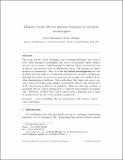Files in this item
Memory versus effector immune responses in oncolytic virotherapies
Item metadata
| dc.contributor.author | Macnamara, Cicely Krystyna | |
| dc.contributor.author | Eftimie, Raluca | |
| dc.date.accessioned | 2016-04-12T23:01:50Z | |
| dc.date.available | 2016-04-12T23:01:50Z | |
| dc.date.issued | 2015-07-21 | |
| dc.identifier | 240256741 | |
| dc.identifier | 3a1184d8-5030-451e-946b-79eba3f8720d | |
| dc.identifier | 84928642630 | |
| dc.identifier.citation | Macnamara , C K & Eftimie , R 2015 , ' Memory versus effector immune responses in oncolytic virotherapies ' , Journal of Theoretical Biology , vol. 377 , pp. 1-9 . https://doi.org/10.1016/j.jtbi.2015.04.004 | en |
| dc.identifier.issn | 0022-5193 | |
| dc.identifier.other | ORCID: /0000-0003-4961-6052/work/27162489 | |
| dc.identifier.uri | https://hdl.handle.net/10023/8604 | |
| dc.description | R.E. acknowledges support from an Engineering and Physical Sciences Research Council (UK) First Grant number EP/K033689/1 | en |
| dc.description.abstract | The main priority when designing cancer immuno-therapies has been to seek viable biological mechanisms that lead to permanent cancer eradication or cancer control. Understanding the delicate balance between the role of effector and memory cells on eliminating cancer cells remains an elusive problem in immunology. Here we make an initial investigation into this problem with the help of a mathematical model for oncolytic virotherapy; although the model can in fact be made general enough to be applied also to other immunological problems. Our results show that long-term cancer control is associated with a large number of persistent effector cells (irrespective of the initial peak in effector cell numbers). However, this large number of persistent effector cells is sustained by a relatively large number of memory cells. Moreover, we show that cancer control from a dormant state cannot be predicted by the size of the memory population. | |
| dc.format.extent | 6309302 | |
| dc.language.iso | eng | |
| dc.relation.ispartof | Journal of Theoretical Biology | en |
| dc.subject | Cancer modelling | en |
| dc.subject | Effector and memory cells | en |
| dc.subject | Tumour control | en |
| dc.subject | Cancer dormancy | en |
| dc.subject | RC0254 Neoplasms. Tumors. Oncology (including Cancer) | en |
| dc.subject | QA Mathematics | en |
| dc.subject | NDAS | en |
| dc.subject | SDG 3 - Good Health and Well-being | en |
| dc.subject.lcc | RC0254 | en |
| dc.subject.lcc | QA | en |
| dc.title | Memory versus effector immune responses in oncolytic virotherapies | en |
| dc.type | Journal article | en |
| dc.contributor.institution | University of St Andrews. Applied Mathematics | en |
| dc.identifier.doi | 10.1016/j.jtbi.2015.04.004 | |
| dc.description.status | Peer reviewed | en |
| dc.date.embargoedUntil | 2016-04-13 |
This item appears in the following Collection(s)
Items in the St Andrews Research Repository are protected by copyright, with all rights reserved, unless otherwise indicated.

